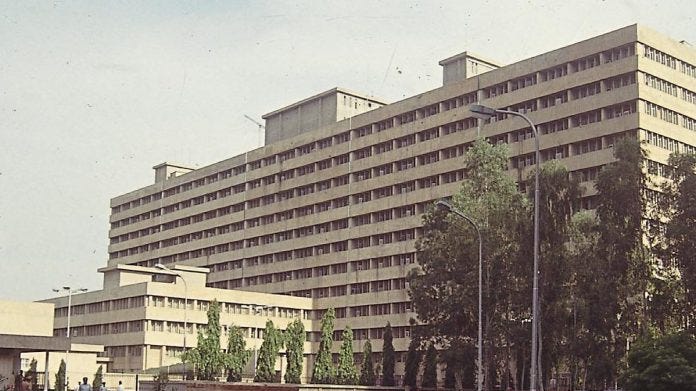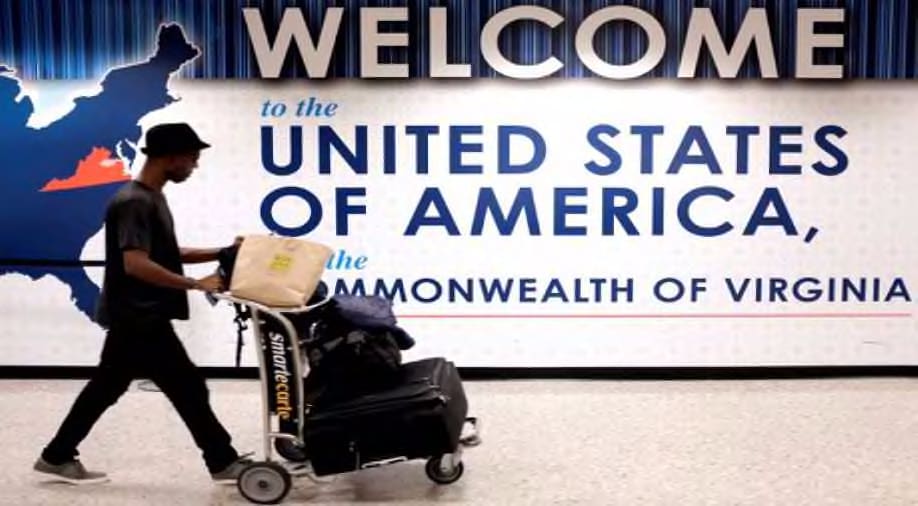Rabinder Singh, double agent
A mediocre R&AW officer and an American diplomat in Damascus, a USAID employee in Delhi, and a CIA officer in Kathmandu.
R&AW Headquarters, Delhi
[This week’s ‘story’ is a well-known case. There are multiple versions of the events involving Rabinder Singh, multiple versions that are hazy, mutually contradictory, and exceptionally light on details. This is normal for anything involving Indian intelligence agencies. The vagueness is not deliberate, at least not on my part.]
Kathmandu, 2004
On 7 May 2004, Mrs Deepa Kumar Sharma and Mr Rajpal Prasad Sharma showed up at Kathmandu airport. Their children studied in the United States, and the Sharmas appeared headed back to them. Bearing American passports, they breezed through immigration and flew to Dulles unmolested.
The Sharmas may have taken this message at face value
By a quirk of fate, they were spared the agony of going through customs and immigration at the airport, an extraordinary occurrence made even more extraordinary by a few other facts. Two intelligence agencies had monitored their passage through the airport. One of those, the CIA, was also responsible for issuing the passports the couple had used.
Mr Sharma was an alias for Rabinder Singh, a Joint Secretary who headed the South-East Asia Desk at R&AW, the other intelligence agency that had monitored the couple’s journey. He had just defected to the United States.
Rabinder Singh
Sometime in December 2003 or January 2004, Singh’s subordinates at the South-East Asia Desk noticed that he was photocopying an unusually large volume of documents. He had also become unusually inquisitive, calling up people and pestering them for information that had little to do with his Desk.
Either that or R&AW’s counterintelligence section caught wind of Singh after a US diplomat posted at the US Embassy in Delhi inadvertently mentioned Singh’s name at a routine liaison session with R&AW. And once they began looking into him, they stumbled upon his habit of asking colleagues for information about matters that didn’t concern him. Whatever the cause that set off the investigation, this habit of his now stood out like a red flag.
He had always been that way, though, and it was only now that his colleagues began putting two and two together. Singh was known for hosting top intelligence officers at lavish parties in Delhi. This may have enabled him to evade detection for a while. But his luck ran out in early 2004.
Early success, 1980s
Singh had pulled off a coup of sorts early on in his career. One of his relatives worked for USAID (which is strongly suspected to be a CIA front organisation), and Singh had managed to procure classified US government documents from him. This brought Singh to the attention of his superiors in R&AW, and might have contributed, to an extent, towards shaping his career trajectory despite being, in B. Raman’s opinion, a mediocre desk officer.
The relative visited India often, and sometimes stayed at Singh’s house. In a possibility reminiscent of Bill Haydon (Tinker Tailor Soldier Spy), Singh used these visits and the classified documents received earlier as cover to pass documents to the CIA through his relative.
A theory floated by other sources suggests that the CIA honey-trapped Singh while he was posted to Cyprus in the late 1980s / early 1990s.
Damascus, 1986
The excess photocopying in 2004 was not, however, the first time Singh had been under suspicion. Originally an officer in the army, Singh had been seconded to R&AW sometime in the 1980s. One of his postings was as First Secretary in the Indian Embassy at Damascus, Syria where the other staffers strongly suspected his real role. It became a topic for gossip among them, and this information found its way out.
Towards the end of the 1980s, a delegation from the Indian Air Force (IAF) made a quiet visit to Syria. With supplies from the Soviet Union falling short of their requirements, they were looking for canopies and other spare parts for Soviet fighter aircraft in the IAF’s inventory. Specifically, MiGs. This delegation was chaperoned, among others, by Singh. They were there because the Syrian Air Force also operated these aircraft, and they were flown to airbases further north from a hush-hush airport located east of Damascus in the middle of an orchard. This was quite likely the Mezzeh Military Airport.
At a diplomatic cocktail party in Damascus, Indian journalist Harish Chandola — who served in Damascus from 1980 to 1992, writing for multiple newspapers — was having a casual conversation with an American diplomat he knew, a First Secretary at the embassy there. During the conversation, the diplomat asked Chandola if he knew about the secret military airfield in the middle of the fruit orchard on the outskirts of Damascus.
The diplomat was hoping to confirm what he had heard, and hoped that Chandola, with the access that he enjoyed as a journalist with connections in the Indian Embassy, could provide corroboration. Chandola knew nothing about the airstrip, of course, but he did ask how the diplomat knew of its existence. If he was willing to tell Chandola about the airfield, he might also tell him about how he found out.
Your man told me. Your man Rabinder Singh told me.
Chandola followed up, asking how Singh would know such a thing.
He knew because he was flown by the Syrians from this airstrip to some airbases in the north.
Chandola later informed the Indian Ambassador about this incident. The ambassador was suitably alarmed that news of a secret visit had leaked, but no action appears to have been taken against Singh at that time.
Delhi, 2004
Singh’s subordinates from the South-East Asia Desk reported their suspicions in January 2004 to the Counterintelligence folks in R&AW who began investigating Singh. They bugged his house and his office and kept him under surveillance for four months, collecting whatever evidence came their way.
They also investigated his finances and discovered that more than a decade ago Singh had been in considerable financial distress. He had even lobbied through a Minister of State for External Affairs for a posting to Washington D.C. to earn extra money.
As evidence kept piling up, towards the end of this period, the counterintelligence section examined his briefcase. They found photocopies of documents that did not belong there. This should have set alarm bells ringing, but for some reason Singh was allowed to proceed on leave.
The evidence wasn’t thought to be sufficient for obtaining a conviction in court. There was no doubt among the counterintelligence officers investigating him, however, that he was spying for the CIA. Given the nature of the evidence they had, there was a fear that a court of law was more likely than not to acquit him, allowing him to continue passing secrets to whoever his handlers were.
Kathmandu, 2004
Other sources claim that permission was sought to prosecute Singh, but this was held up at a higher level. While the leadership debated their preferred course of action, early in the morning on 1 May 2004, Singh and his wife hitched a ride in a friend’s car and crossed over into Nepal.
Their stay there was facilitated by David Vacala, an employee with the US Embassy in Kathmandu. Vacala booked the hotel room in his own name, and the tickets he purchased for Mrs and Mr Sharma listed Vacala’s name and address at the embassy. Their passports—American passports—had been issued on 7 April 2004.
David Vacala, recent years
Vacala’s mistakes while booking their accommodation and air tickets had enabled R&AW’s operatives in Kathmandu to figure out what was going on. This intelligence was duly sent to Delhi. But even though they knew Singh’s itinerary, no effort was made to intercept him and his wife before they flew to the US. An explanation of sorts can be gleaned from the kind of evidence they had against him and the consequent fear of him going scot-free, as well as what one of the counterintelligence agents who had investigated Singh later said:
It was a great success! We got exactly what we wanted!
Aftermath
R&AW’s investigation after Singh’s defection suggested that he could have handed over thousands of files to the CIA. The investigation also reportedly identified 57 R&AW officers who had inadvertently shared information with Singh. Of these, two dozen were believed to have actively colluded with him and are reported to have been packed off to insignificant positions. R&AW is also said to have taken measures to protect their assets abroad just in case Singh had betrayed them.
For Singh, the defection turned out to be a terrible mistake. A few months after he landed in Dulles, the CIA discarded him. They stopped paying him, scuppered his attempt at gaining employment with a think tank, and declined to support his request for naturalisation. By the end of 2004 itself, his hopes of a decent life in the US had been betrayed. Singh died in 2016.
Postscript
Surender Jeet Singh v. John Ashcroft, Attorney General investigates what happened to Rabinder Singh after his defection.
If you enjoyed reading this and would like to read more, subscribe to Espionage& on Substack using the button below.
You’ll also enjoy reading my spy novels: Let Bhutto Eat Grass & Let Bhutto Eat Grass: Part 2 deal with nuclear weapons espionage in 1970s India, Pakistan, and Europe.







